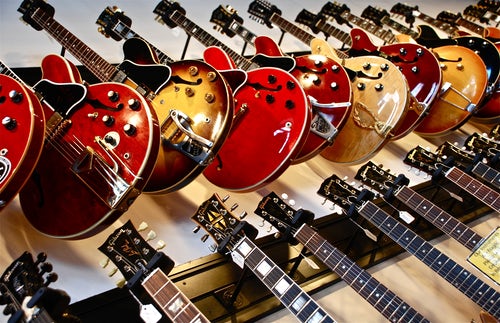Rock On With A Perfectly Tuned Guitar
 Guitar is a string instrument that sounds best when tuned properly. New guitar learners may often wonder why their guitars do not sound as they wish them to. It is difficult to play a single note at a perfect tune in the initial days of training. However, the difficulty gets multiplied if the guitar is not in proper tune. For a new learner of this wonderful string instrument, tuning a guitar is a tough job. He/she should, therefore, begin his/her training with the guidance of how to tune a guitar. Often, it so happens that an experienced guitar player fails to achieve the desired effect in music even after playing an entire song properly on his/her guitar. The problem lies nowhere but in the lack of fine tuning. This is why it is advisable to tune the guitar every time the guitar is to be played.
Guitar is a string instrument that sounds best when tuned properly. New guitar learners may often wonder why their guitars do not sound as they wish them to. It is difficult to play a single note at a perfect tune in the initial days of training. However, the difficulty gets multiplied if the guitar is not in proper tune. For a new learner of this wonderful string instrument, tuning a guitar is a tough job. He/she should, therefore, begin his/her training with the guidance of how to tune a guitar. Often, it so happens that an experienced guitar player fails to achieve the desired effect in music even after playing an entire song properly on his/her guitar. The problem lies nowhere but in the lack of fine tuning. This is why it is advisable to tune the guitar every time the guitar is to be played.
Tuning a Guitar
Playing a guitar for a long time without paying attention to whether the guitar is in tune or not, actually harms the guitar and affects the quality of its melody. Constant practising on a guitar without tuning it can lead the guitar go out of tune altogether. Matured and experienced guitarists always tend to take out some time for tuning their guitar before any live performance. One should actually tune the guitar as frequently as possible. In the initial days of a new learner’s introduction to his/her guitar, it usually takes quite some time to tune the guitar properly. However, as the learner gets more familiar with the instrument he/she can put his/her guitar in tune quickly whenever the need arises. In order to tune a guitar, one requires a reference pitch. One can use a piano or any other musical instrument as the reference pitch resource. The tuner has to make sure that the reference pitch resource is in proper tune and scale.
A guitar player can do away with the reference pitch resource and tune his/her guitar on his own. Such a guitar will sound good in a solo performance when there is no other instrument playing along with it. The problem arises when a couple of other instruments are also supposed to be played along with a guitar. Then, such an individually tuned guitar (without the help of any reference pitch) might sound out of tune. In such a situation, the guitar has to be in the same tune and scale as the other musical instruments. This synchronisation is most necessary in a performance where multiple musical aids are in work to achieve the perfect musical balance. In the process of tuning a guitar one actually assigns pitches to the open strings of this string instrument. In standard tuning, the string pitches are defined as E, A, D, G, B, E, i.e. from the low E to the high E. Most of the guitarists across the world prefer and use standard tuning as mentioned above. Other frequently used tunings are accepted as variations on the standard tuning.
Greetings! This is my first comment here so I just wanted to give a quick shout out and say I really enjoy reading through your articles. Can you recommend any other blogs/websites/forums that cover the same topics? Thanks for your time!
Hello very cool web site!! Guy .. Beautiful .. Wonderful .. I will bookmark your website and take the feeds I’m glad to search out so many useful info here in the publish, we’d like work out extra strategies on this regard, thanks for sharing. . . . . .